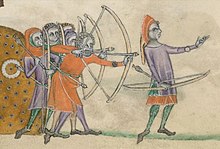Hello ladies and gents this is the viking telling you that today we are for the first time talking about a ranged weapon on here we hope you like it
 The earliest known example of a longbow was found in 1991 in the Ötztal Alps with a natural mummy known as Ötzi. His bow was made from yew and was 1.82 metres (72 in) long; the body has been dated to around 3,300 BC and another bow made from yew was found within some peat in Somerset, England dated to 2700–2600 BC. Forty longbows have been discovered in a peat bog at Nydam in Denmark which date from the 4th century AD.
The earliest known example of a longbow was found in 1991 in the Ötztal Alps with a natural mummy known as Ötzi. His bow was made from yew and was 1.82 metres (72 in) long; the body has been dated to around 3,300 BC and another bow made from yew was found within some peat in Somerset, England dated to 2700–2600 BC. Forty longbows have been discovered in a peat bog at Nydam in Denmark which date from the 4th century AD.
In the Middle Ages the Welsh and English were famous for their very powerful longbows, used en masse to great effect against the French in the Hundred Years' War, with notable success at the battles of Crécy (1346), Poitiers (1356), and Agincourt (1415). During the reign of Edward III of England, laws were passed allowing fletchers and bowyers to be impressed into the army and enjoining them to practice archery. The dominance of the longbow on the battlefield continued until the French began to use cannon to break the formations of English archers at the Battle of Formigny (1450) and the Battle of Castillon (1453).
Their use continued in the Wars of the Roses however and they survived as a weapon of war in England well beyond the introduction of effective firearms. The average length of arrow shafts recovered from the 1545 sinking of the Mary Rose is 75 cm/30 in. In 1588, the militia was called out in anticipation of an invasion by the Spanish Armada and it included many archers in its ranks; the Kent militia for instance, had 1,662 archers out of 12,654 men mustered.
The Battle of Flodden (1513) was "a landmark in the history of archery, as the last battle on English soil to be fought with the longbow as the principal weapon..." The Battle of Tippermuir (1644), in Scotland, may have been the last battle involving the longbow in significant numbers. The last recorded use of the longbow in war was by British Lt. Col. Jack Churchill, who used it to kill a German soldier in World War II
We hope you liked this post and as always have a chilled day from the viking.
LONGBOW
 The earliest known example of a longbow was found in 1991 in the Ötztal Alps with a natural mummy known as Ötzi. His bow was made from yew and was 1.82 metres (72 in) long; the body has been dated to around 3,300 BC and another bow made from yew was found within some peat in Somerset, England dated to 2700–2600 BC. Forty longbows have been discovered in a peat bog at Nydam in Denmark which date from the 4th century AD.
The earliest known example of a longbow was found in 1991 in the Ötztal Alps with a natural mummy known as Ötzi. His bow was made from yew and was 1.82 metres (72 in) long; the body has been dated to around 3,300 BC and another bow made from yew was found within some peat in Somerset, England dated to 2700–2600 BC. Forty longbows have been discovered in a peat bog at Nydam in Denmark which date from the 4th century AD.In the Middle Ages the Welsh and English were famous for their very powerful longbows, used en masse to great effect against the French in the Hundred Years' War, with notable success at the battles of Crécy (1346), Poitiers (1356), and Agincourt (1415). During the reign of Edward III of England, laws were passed allowing fletchers and bowyers to be impressed into the army and enjoining them to practice archery. The dominance of the longbow on the battlefield continued until the French began to use cannon to break the formations of English archers at the Battle of Formigny (1450) and the Battle of Castillon (1453).
Their use continued in the Wars of the Roses however and they survived as a weapon of war in England well beyond the introduction of effective firearms. The average length of arrow shafts recovered from the 1545 sinking of the Mary Rose is 75 cm/30 in. In 1588, the militia was called out in anticipation of an invasion by the Spanish Armada and it included many archers in its ranks; the Kent militia for instance, had 1,662 archers out of 12,654 men mustered.
The Battle of Flodden (1513) was "a landmark in the history of archery, as the last battle on English soil to be fought with the longbow as the principal weapon..." The Battle of Tippermuir (1644), in Scotland, may have been the last battle involving the longbow in significant numbers. The last recorded use of the longbow in war was by British Lt. Col. Jack Churchill, who used it to kill a German soldier in World War II
We hope you liked this post and as always have a chilled day from the viking.
Comments
Post a Comment